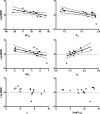Evaluating the Metal Tolerance Capacity of Microbial Communities Isolated from Alberta Oil Sands Process Water
- PMID: 26849649
- PMCID: PMC4743850
- DOI: 10.1371/journal.pone.0148682
Evaluating the Metal Tolerance Capacity of Microbial Communities Isolated from Alberta Oil Sands Process Water
Abstract
Anthropogenic activities have resulted in the intensified use of water resources. For example, open pit bitumen extraction by Canada's oil sands operations uses an estimated volume of three barrels of water for every barrel of oil produced. The waste tailings-oil sands process water (OSPW)-are stored in holding ponds, and present an environmental concern as they are comprised of residual hydrocarbons and metals. Following the hypothesis that endogenous OSPW microbial communities have an enhanced tolerance to heavy metals, we tested the capacity of planktonic and biofilm populations from OSPW to withstand metal ion challenges, using Cupriavidus metallidurans, a known metal-resistant organism, for comparison. The toxicity of the metals toward biofilm and planktonic bacterial populations was determined by measuring the minimum biofilm inhibitory concentrations (MBICs) and planktonic minimum inhibitory concentrations (MICs) using the MBEC ™ assay. We observed that the OSPW community and C. metallidurans had similar tolerances to 22 different metals. While thiophillic elements (Te, Ag, Cd, Ni) were found to be most toxic, the OSPW consortia demonstrated higher tolerance to metals reported in tailings ponds (Al, Fe, Mo, Pb). Metal toxicity correlated with a number of physicochemical characteristics of the metals. Parameters reflecting metal-ligand affinities showed fewer and weaker correlations for the community compared to C. metallidurans, suggesting that the OSPW consortia may have developed tolerance mechanisms toward metals present in their environment.
Conflict of interest statement
Figures



Similar articles
-
Harnessing oil sands microbial communities for use in ex situ naphthenic acid bioremediation.Chemosphere. 2014 Feb;97:78-85. doi: 10.1016/j.chemosphere.2013.11.016. Epub 2013 Dec 8. Chemosphere. 2014. PMID: 24325800
-
Naphthenic acids speciation and removal during petroleum-coke adsorption and ozonation of oil sands process-affected water.Sci Total Environ. 2011 Nov 1;409(23):5119-25. doi: 10.1016/j.scitotenv.2011.08.033. Epub 2011 Sep 9. Sci Total Environ. 2011. PMID: 21907388
-
Removal and biodegradation of naphthenic acids by biochar and attached environmental biofilms in the presence of co-contaminating metals.Bioresour Technol. 2016 Sep;216:352-61. doi: 10.1016/j.biortech.2016.05.084. Epub 2016 May 26. Bioresour Technol. 2016. PMID: 27259191
-
Bioreactors for oil sands process-affected water (OSPW) treatment: A critical review.Sci Total Environ. 2018 Jun 15;627:916-933. doi: 10.1016/j.scitotenv.2018.01.292. Epub 2018 Feb 3. Sci Total Environ. 2018. PMID: 29426216 Review.
-
The toxicity of oil sands process-affected water (OSPW): A critical review.Sci Total Environ. 2017 Dec 1;601-602:1785-1802. doi: 10.1016/j.scitotenv.2017.06.024. Epub 2017 Jun 11. Sci Total Environ. 2017. PMID: 28618666 Review.
Cited by
-
Finding the best combination of autochthonous microorganisms with the most effective biosorption ability for heavy metals removal from wastewater.Front Microbiol. 2022 Oct 6;13:1017372. doi: 10.3389/fmicb.2022.1017372. eCollection 2022. Front Microbiol. 2022. PMID: 36267171 Free PMC article.
-
Use of Microbial Consortia in Bioremediation of Metalloid Polluted Environments.Microorganisms. 2023 Mar 30;11(4):891. doi: 10.3390/microorganisms11040891. Microorganisms. 2023. PMID: 37110315 Free PMC article. Review.
-
The good, the bad, and the ugly of metals as antimicrobials.Biometals. 2024 Jun;37(3):545-559. doi: 10.1007/s10534-023-00565-y. Epub 2023 Dec 19. Biometals. 2024. PMID: 38112899 Free PMC article. Review.
-
Codon usage bias reveals genomic adaptations to environmental conditions in an acidophilic consortium.PLoS One. 2018 May 9;13(5):e0195869. doi: 10.1371/journal.pone.0195869. eCollection 2018. PLoS One. 2018. PMID: 29742107 Free PMC article.
References
-
- Allen EW. Process water treatment in Canada’s oil sands industry: I. Target pollutants and treatment objectives. J. Environ. Eng. Sci. 2008;7:123–38.
-
- Quagraine EK, Peterson HG, Headley J V. In situ bioremediation of naphthenic acids contaminated tailing pond waters in the Athabasca oil sands region—demonstrated field studies and plausible options: A review. J. Environ. Sci. Heal. Part A Toxic/Hazardous Subst. Environ. Eng. 2005;40:685–722. - PubMed
-
- National Energy Board. Canada’s Oil Sands—Opportunities and challanges to 2015: an update Calgary, AB: National Energy Board; 2006.
-
- Suncor. Suncor report on sustainability 2013. 2013. Available: http://sustainability.suncor.com/2013/pdf/se_ros13_prod_proof_E_WEB.pdf
Publication types
MeSH terms
Substances
LinkOut - more resources
Full Text Sources
Other Literature Sources

